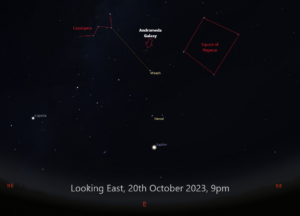October Stargazing
A hundred years ago, astronomers were uncertain about the nature of diffuse objects in the sky that they called ‘spiral nebulae’. The work of Edwin Hubble (for whom the famous Space Telescope is named) and his exceptionally talented collaborator, Milton Humason, made it clear that these were many times more distant than any of the other astronomical objects they could see. They briefly became known as ‘island universes’; we now call them ‘galaxies’.
This month, our Dark Skies Advisor, Steve Tonkin, will show you how to see one of these galaxies – the Andromeda Galaxy.
You’ll need a clear night, away from artificial lights, and to give your eyes at least fifteen minutes (longer is better) to become dark-adapted. Use the chart pictured below to identify the “W” shape of the bright stars of Cassiopeia, about two thirds of the way from the horizon to the zenith at about 9pm. Use the upper “V” as an arrowhead, to point you to a yellowish star (Mirach) about a hand span away if you stretch your arm out in front of you. Just above Mirach (a bit more than an outstretched finger-width) is a fainter white star and, exactly the same distance above the white star you should see a faint fuzzy patch. (If you can’t see it with your unaided eye, it is very easy to see in binoculars.) This is the Andromeda Galaxy.

You are looking at the light of a thousand billion stars (that’s a one followed by twelve zeroes!) stars that has taken two and a half million years to get here; that light began its journey around the same time as our ancestors, Homo habilis, first appeared!
This autumn and winter, we will be putting on a number of stargazing events where, weather permitting, we can show you galaxies and many of the other wonders of the night sky. Details of these will appear in our newsletters and on our website. We look forward to seeing you!
Find out more about Dark Night Skies on Cranborne Chase National Landscape.
